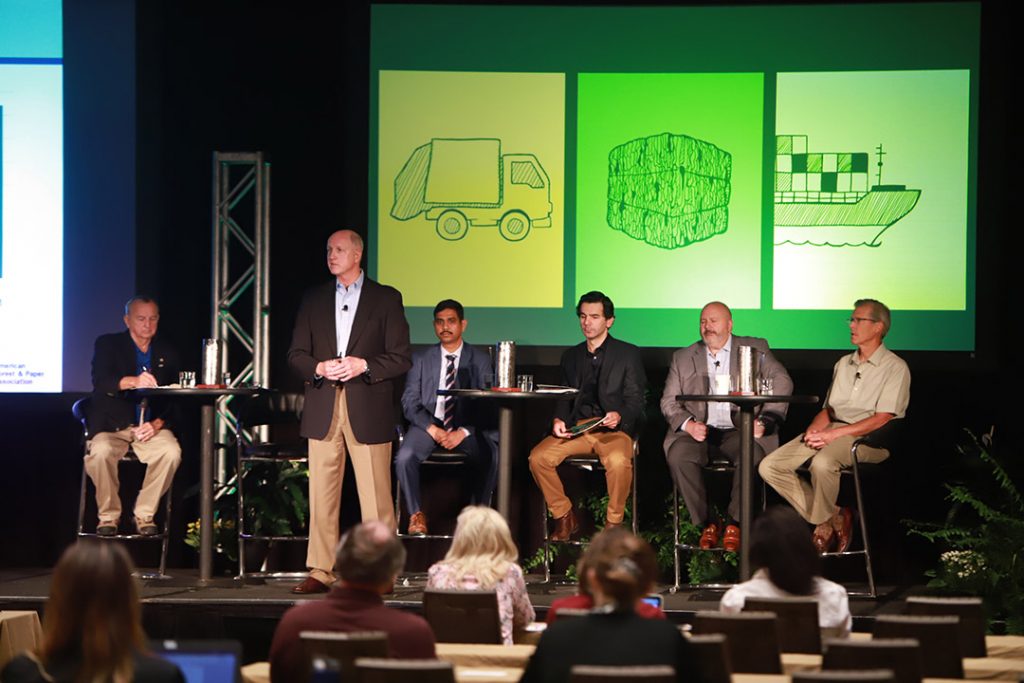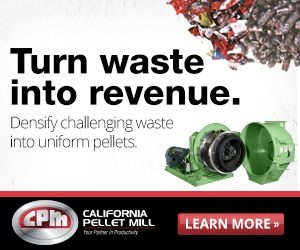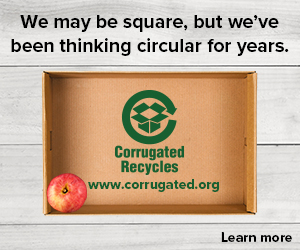
From left: Mick Barry, Brian Hawkinson, Shailesh Gothal, Dave Yousif, Mark Bond and Dave Claugus at the 2019 Resource Recycling Conference and Trade Show. | Brian Adams Photography/Resource Recycling Conference
MRF operators, brokers and others recently discussed why fiber is still “the elephant in the room” in municipal recycling conversations.
During a recovered fiber session at the 2019 Resource Recycling Conference and Trade Show in New Orleans, stakeholders from throughout the paper recycling sector discussed where the market is and where it’s headed.
Fiber is the “elephant in the room” as far as the value of the residential mix that municipalities receive, said Dave Claugus, vice president of Pacific Northwest MRF operator Pioneer Recycling Services.
The session featured experts from the American Forest & Paper Association, Gemini Corporation, the Continuous Improvement Fund, Sustana Fiber and Pioneer Recycling Services. It was moderated by Mick Barry of Mid-America Recycling.
Why the fiber focus?
Paper is the “main event” at a MRF, said Claugus. In the Pacific Northwest, paper makes up 75% of the material that comes onto the tip floor Monday through Friday.
“That means that paper moves the price of whatever the processor can pay or needs to charge the municipality,” Claugus said.
For example, if paper moves by $10 per ton, it is going to influence the combined value of recyclables by $7.50 per ton. If PET moves by $10 per ton, on the other hand, that would influence the combined value of the recycling stream by just 25 cents per ton due to its smaller volume in the stream.
Claugus argued there is an inelastic supply of recycled paper at the MRFs, meaning the supply does not respond to price and is relatively fixed.
“The generators of this material are totally disconnected from price. They have no price signal and so they don’t respond,” he said. This dynamic represents a “huge change” from when Claugus got started in the industry 40 years ago, he added, and the inelasticity has “profound” implications for the pricing of the material.
Under this dynamic, “when you have a shift in demand you’re not sliding gently down a supply curve, you’re falling off a cliff, and that’s why the pricing for recycled materials are so volatile,” he said.
Claugus also offered his opinion that volatility is the norm in the pricing of recyclables and that stability is the exception. And recognizing these realities, he said, is key to making sustainable recycling contracts.
“The generators of this material are totally disconnected from price. They have no price signal and so they don’t respond.” – Dave Claugus, Pioneer Recycling Services
“This is huge; everybody needs to understand this,” he said. “It should be part of your thinking as you approach any kind of contract renegotiation whether you’re a MRF or a municipality.”
Mixed-paper market snapshot
China’s import restrictions heavily impacted mixed paper, as the country went from taking hundreds of thousands of tons per year to buying virtually none.
Brian Hawkinson of the American Forest & Paper Association (AF&PA) detailed the domestic mixed-paper market, which has received much attention in the wake of the overseas restrictions.
Over the long run, mixed paper is making up a smaller percentage of all recovered fiber consumed in the U.S. In 2009 it was slightly more than 14%, and by 2018 it had dropped to just more than 12%.
“The biggest by far, of course, is OCC,” Hawkinson said, noting that grade makes up about 71% of all recovered fiber consumed in the U.S.
Mixed paper finds two main end markets in the U.S. Recycled paperboard claims 39% of the mixed paper that moves to market in the U.S., and another 37% goes into containerboard. The tissue market takes 19% of the mixed paper, and the remaining 5% goes into construction applications and other paper product grades. This is much different than a decade ago, when packaging was a smaller percentage.
The mixed-paper export market has also shifted dramatically over the past decade, and not just because of the turbulence over the past two years.
Citing U.S. Census Bureau data, Hawkinson showed that mixed-paper exports dropped substantially in 2010 concurrent with the U.S. economic downturn. That year alone, exports dropped from more than 7.5 million short tons to less than 5 million. Exports remained pretty stable between 4 and 5 million tons per year until 2015, when they started a downward slide that continued through 2018.
Details on the largest new market
Export destinations for recovered fiber have shifted dramatically, as well. India has become the current largest buyer of U.S. recovered fiber, and an expert says it is poised to be a strong market for the material moving into the future.
There are around 700 mills and that volume is growing, said Shailesh Gothal of Gemini Corporation, which brokers recyclables. Those mills are relatively small in size, with a typical Indian mill having a capacity of 100 to 250 metric tons per day, he said.
“But all in all, it is helping whatever China is not taking; India is trying to take a little bit more and help paper recycling,” he said.
Of the Indian paper mills, 65% are dependent on imported recovered fiber, he said.
Though the markets are very bad currently, India has an advantage in its population, Gothal said. The country is going through a period of greater urbanization and the government is stable, which will increase the per-capita consumption of paper, he said, particularly given the country’s massive population.
U.S.-sourced paper makes up 45% of the weight imported in India. The Middle East, meanwhile, contributes 25%, Europe makes up 15% and all other countries contribute the remaining 15%.
By grade, 15% of the newsprint consumed by Indian mills comes from within the country, with 85% being imported. But experts say newsprint is a “dying industry” in India, Gothal said, because no more investments are coming on the newsprint side.
“India is trying to take a little bit more and help paper recycling.” -Shailesh Gothal of Gemini Corporation
“Many mills are converting newsprint mills to kraft mills,” he said, a trend that has been unfolding around the world. Printing and writing grades remain relatively strong, he said. But kraft packaging is the strongest grade in India, with upwards of 70% of Indian mills producing these materials.
How North American municipalities are responding
In the months following China’s January 2018 implementation of sharper recovered material import restrictions, the Continuous Improvement Fund (CIF) of Ontario received “numerous and almost weekly calls from municipalities asking for support and advice and impacts associated with the National Sword,” said Dave Yousif, project manager for CIF, which works to improve municipal blue box recycling programs throughout Ontario.
Similar to the Pacific Northwest, paper plays a critical role in Ontario’s recycling programs. Almost 75% of the recyclables marketed in Ontario are fiber products, so “the gravity of the situation and potential impact was significant,” Yousif said.
In response to the inquiries from municipalities, CIF recommended recycling programs improve their operational systems through fiber sortation upgrades. This improves the quality of the output, in turn increasing market access into higher-grade end markets, which Yousif said are more available domestically than low-grade end markets.
“We’ve supported market development in the past, particularly in the field of plastics, but attempting to develop a fiber market is a whole different beast,” he said. Therefore, the best step municipalities can take is to improve their quality.
Yousif pointed to several municipalities that have upgraded their fiber optical sorting systems, installed ballistic separators and even completed entire MRF retrofits to include artificial intelligence robotics.
In a small number of cases, Ontario municipalities have converted from single-stream to dual-stream collection, another step aiming to improve recycling stream quality.
Domestic expansion details
Several speakers pointed to signs for improvement on the horizon, citing a handful of mills coming on-line with recovered fiber capacity expansions.
“It’s a mix of reasons why the new capacity increases are coming on-line,” said Hawkinson of AF&PA, explaining some mills that used to make grades such as newsprint are shifting into recycled packaging, and other idled mills are coming back on-line.
Claugus of Pioneer Recycling Services noted that “with each one of these projects, it is going to, all other things being equal, impact price.” Still, he pointed out a significant “Achilles heel” in his prediction: the caveat of “all other things being equal.”
“The real world is that every action begets a reaction, and so the real world is constantly changing,” Claugus said. “So it’s very likely, for example, that some of the assumptions investors made when they announced these projects, by the time they get around to actually spending the money, will have changed to the degree that now they’re not so sure if they want to go ahead with the project.”
Existing outlets explore new streams
As some of these North American mills prepare to expand their recycled paper purchasing, other mills that have been involved in the recycling sector for years are continuing to advance domestic paper recovery, including with innovative end uses.
Sustana Fiber operates two pulp facilities, one in Wisconsin and one outside Quebec City. These two mills create 250,000 tons per year of “the best recycled white fiber” in North America, said Mark Bond, sales manager for specialty fibers and sustainability at Sustana.
The company takes in 1,000 tons per day of sorted office paper and aseptic and gable-top carton bales, Bond said, and recycles them into new fiber products. The company produces tissue, printing and writing products, and packaging and food-service products.
Sustana produces 100% recycled packaging under the Envirolife brand, which can be used in direct food contact applications. This fiber can be used in lightweight and heavyweight paper packaging to-go products, Bond said.
The food-contact application means some additional requirements of the recycled fiber, such as the material being fluorocarbon free and having other safety measures.
Sustana is involved in pushing forward recovery and recycling of additional fiber streams, as well. Bond referenced a recent project Sustana completed in partnership with Starbucks, WestRock and Seda Packaging, recycling 25 million Starbucks single-use coffee cups for use in new coffee cups.
More stories about fiber
- Graphic Packaging reports rising post-consumer content
- Packaging Corp. to buy Greif containerboard segment
- Fiber end users talk price increases, demand outlook



